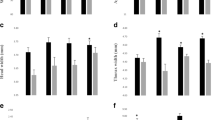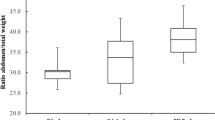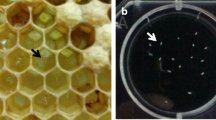Summary
We have formulated a tissue culture medium based on the components of larval honey bee hemolymph. Using an in vitro radiochemical assay to measure juvenile hormone biosynthesis, we compared our larval-based medium to four commercially available media (Grace’s, Medium-199; Shields and Sang M3, and Minimum Essential Medium), and a medium based on adult honey bee hemolymph. All media were formulated without methionine. There was no significant difference in the amounts of juvenile hormone produced by the larval medium and Grace’s; both of these media, however, were more suitable than the remaining four. Our larval-based tissue culture medium should prove useful in studies aimed at elucidating the underlying hormonal mechanism(s) of caste development in honey bees.
Similar content being viewed by others
References
Bounias, M. Intra-glycemic relations occurring during the development of honey bee workers (Apis mellific mellifica L.). Comp. Biochem. Physiol. 61A:13–18; 1978.
Feyereisen, R.; Tobe, S. S. A rapid partition assay for routine analysis of juvenile hormone released by insect corpora allata. Anal. Biochem. 111:372–375; 1981.
Florkin, M.; Jeuniaux, C. Hemolymph: composition. In: Rockstein, M., ed. The physiology of the insecta. Vol. 5. New York: Academic Press; 1974:255–307.
Giauffret, A. Cell culture of Hymenoptera. In: Vago, C., ed. Invertebrate tissue culture. Vol. 1. New York: Academic Press; 1971:295–305.
Hartfelder, K. Structure and function of the prothoracic gland in honey bee (Apis mellifera L.) development. Invertebr. Reprod. Dev. 23:59–74; 1993.
Hartfelder, K.; Köstlin, K.; Hepperle, C. Ecdysteroid-dependent protein synthesis in caste-specific development of the larval honey bee ovary. Roux’s Arch. Dev. Biol. 205:73–80; 1995.
Hartfelder, K.; Tozetto, S. de O.; Rachinsky, A. Sex-specific developmental profiles of juvenile hormone synthesis in honey bee larvae. Roux’s Arch. Dev. Biol. 202:176–180; 1993.
Judy, K. J.; Schooley, D. A.; Dunham, L. L., et al. Isolation, structure, and absolute configuration of a new natural insect juvenile hormone from Manduca sexta. Proc. Natl. Acad. Sci. USA 70:1509–1513; 1973.
Kaatz, H.-H.; Hagedorn, H. H.; Engels, W. Culture of honey bee organs: development of a new medium and the importance of tracheation. In Vitro Cell. Dev. Biol. 21:347–352; 1985.
Kaatz, H.-H.; Hildebrandt, H.; Engels, W. Primer effect of queen pheromone on juvenile hormone biosynthesis in adult worker honey bees. J. Comp. Physiol. B 162:588–592; 1992.
Milani, N. Proprietà fisiche e composizione chimica dell’emolinfa in Apis mellifera L.: una rassegna bibliografica. Apicoltura (Rome), Supplement 4, 1988.
Pratt, G. E.; Tobe, S. S. Juvenile hormone radiobiosynthesised by corpora allata of adult female locusts in vitro. Life Sci. 14:575–586; 1974.
Rachinsky, A. Octopamine and serotonin influence on corpora allata activity in honey bee (Apis mellifera) larvae. J. Insect Physiol. 40:549–554; 1994.
Rachinsky, A. Brain and suboesophageal ganglion extracts affect juvenile hormone biosynthesis in honey bee larvae (Apis mellifera carnica). Zoology 99:277–284; 1996.
Rachinsky, A.; Engels, W. Caste development in honey bees (Apis mellifera): juvenile hormone turns on ecdysteroids. Naturwissenschaften 82:378–379; 1995.
Rachinsky, A.; Hartfelder, K. Corpora allata activity, a prime regulating element for caste-specific juvenile hormone titre in honey bee larvae (Apis mellifera carnica). J. Insect Physiol. 36:189–194; 1990.
Rachinsky, A.; Hartfelder, K. Differential production of juvenile hormone and its desoxy precursor by corpora allata of honeybees during a critical period of caste development. Naturwissenschaften 78:270–272; 1991.
Schooley, D. A.; Baker, F. C. Juvenile hormone biosynthesis. In: Kerkut, G. A.; Gilbert, L. I. Comprehensive insect physiology, biochemistry, and pharmacology. Vol. 7. Oxford, England: Pergamon Press; 1985:363–389.
Tobe, S. S.; Pratt, G. E. The influence of substrate concentrations on the rate of insect juvenile hormone biosynthesis by corpora allata of the desert locust in vitro. Biochem. J. 144:107–113; 1974.
Tobe, S. S.; Stay, B. Structure and regulation of the corpus allatum. Adv. Insect Physiol. 25:305–432; 1985.
Wahrman, M. Z.; Zhu, S. Haploid and diploid cell cultures from a haplodiploid insect. Invertebr. Reprod. Dev. 24:79–86; 1993.
Author information
Authors and Affiliations
Rights and permissions
About this article
Cite this article
Rachinsky, A., Hartfelder, K. In vitro biosynthesis of juvenile hormone in larval honey bees: Comparison of six media. In Vitro Cell.Dev.Biol.-Animal 34, 646–648 (1998). https://doi.org/10.1007/s11626-996-0014-x
Received:
Accepted:
Issue Date:
DOI: https://doi.org/10.1007/s11626-996-0014-x




